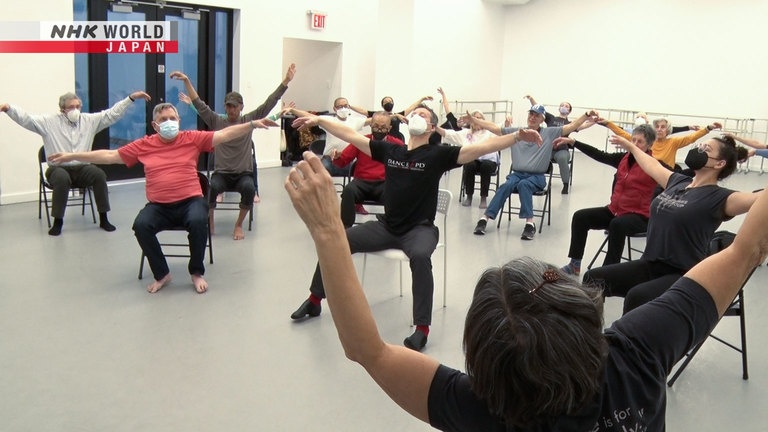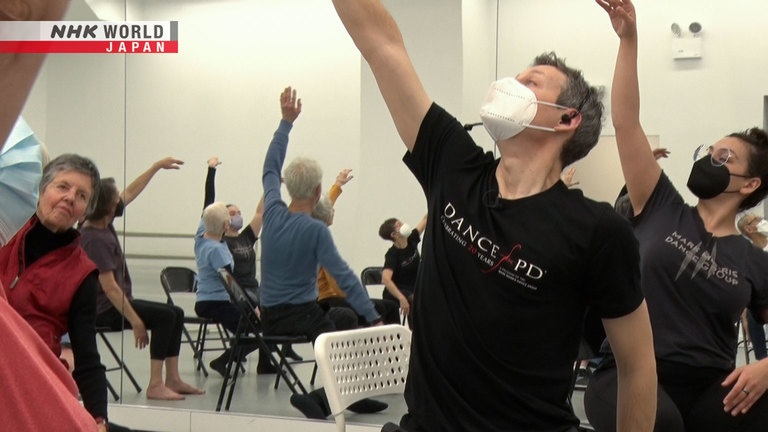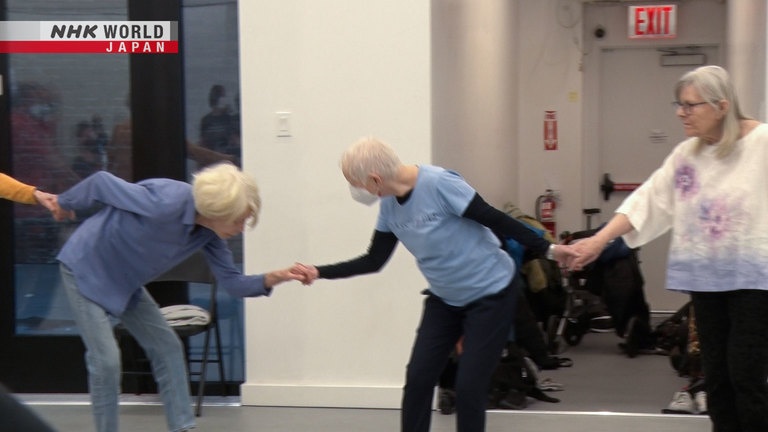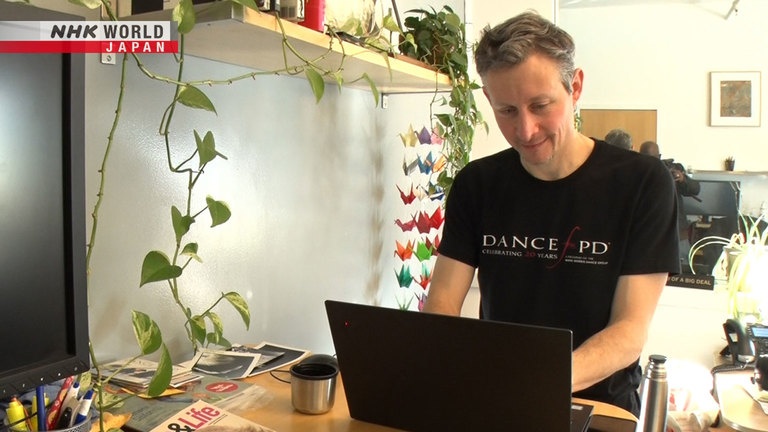Joyful Moves to Counter Parkinson's: David Leventhal / Program Director, Dance for PD
Modern dancer David Leventhal co-created a dance program for people with Parkinson's. 20 years later numerous studies have proven that dancing slows the progression of the neurodegenerative disorder.




Transcript
Direct Talk
A unique dance program,
gaining global recognition.
Dance for PD
offers classes for people
living with Parkinson's Disease,
the neurodegenerative disorder
with symptoms such as
tremors,
impaired balance
and slowed movement.
Dance for PD is a community program
of the NYC-based modern dance company,
the Mark Morris Dance Group,
and is taught by professional dancers.
David Leventhal is
one of the founding teachers
and the program director of Dance for PD.
We're helping people train as dancers.
The Parkinson's diagnosis is
a door through which we can
integrate as many dance tools
to help those individuals live well,
to live with confidence.
We ask David Leventhal
about this award-winning dance program
that is making a positive impact on the
lives of people living with Parkinson's.
Joyful Moves to Counter Parkinson's
Brooklyn, New York, is home to the
world-renowned modern dance company,
the Mark Morris Dance Group.
This is a flagship location
of Dance for PD.
Classes are offered free of charge.
The class begins from a seated position
I thought today we could start with
this idea of shapes.
One of them is this kind of a diamond shape.
So, what I'd like you to start doing
is just to think about using
that diamond shape as your lens.
And seven, here we go.
Allow yourself to see
the room through that shape.
Using imagery
Leventhal gently guides participants
to move their bodies through space.
Pressing your hands, expanding out,
as you can, opening your eyes,
your mouth, your nose, your face, open...
Dance is good for people with Parkinson's
on a number of different levels.
I tend to think about four areas.
Number one is physical.
We see
beneficial impacts on balance,
functional mobility,
gait,
tremor,
facial expression.
And these are really fundamental elements
that affect many, many people
with Parkinson's.
Then there's what are called
the cognitive elements.
There's more and more evidence
in the research to show that
dance is really good for us
cognitively.
We have to think about patterns.
We have to think strategically
about choreographic problems
that come up,
how do I move forward?
How do I move backward?
How do I move around somebody?
So that kind of problem-solving
challenges our brains,
and as we age,
we need to do more of that
to keep our cognitive function.
The third element is expressive.
I think about Parkinson's
as an anti-theatrical condition.
It robs you of the ability to express big
ideas with your body,
it takes away vocal projection.
It takes away enunciation.
So, dance gives back the power of expression,
how can I express myself
through my body?
How can I get out of the very internal
Parkinson's posture and
think about myself as a performer,
think about myself as
projecting my movements to others.
And
finally,
the social environment.
In Parkinson's,
you often lose your social networks,
you lose
connections with work colleagues,
you're not working anymore,
you're feeling
ambivalent about
going out into social settings
because you feel awkward in your body,
you're not comfortable there.
So. to be in a space where you're welcome,
you have a sense of belonging, and
you get to connect with others,
has a deep social benefit of
knowing that you're part of community.
An accompanist providing live music
is an integral part of Dance for PD classes.
In contrast with
most remedial movement therapies, here,
the focus is on each participant's
artistic exploration.
Parkinson's is a situational condition.
What I mean by that is
when you change the situation,
when you change the prompt,
you often can
help somebody move
in a way that they otherwise can't.
So a great example is that
sometimes in class, we see,
sort of in-between exercises,
people experience freezing,
it's like their feet are stuck on the floor,
and they just can't take that next step.
Well, we have a couple of techniques that can
help people start to shift their weight.
One is a very strong rhythm,
that external cue
of rhythmic prompt
can help somebody and train their movement
to that rhythm and start to move.
An image can help too,
or dancing across from somebody,
making eye contact with them
and starting to march with them.
So they actually mirror
their movements to you.
All of those are,
they are very strong external inputs.
And that's exactly what's helpful
for people with Parkinson's,
who are often having trouble
accessing that internal automaticity.
Since the creation of Dance for PD,
over 45 peer-reviewed studies
have proven beyond doubt
the benefits of dancing on
people living with Parkinson's.
My neurologist said that
she noticed that ever since
I started the dance program,
the measurements that she takes
every time I see her have improved.
And actually I was able to decrease
my Parkinson's medications.
Last fall was December 18th,
and I certainly haven't fallen since then.
I really am feeling better, less pain.
David Leventhal grew up
in Boston, Massachusetts,
and was an avid figure skater as a child.
At age eight, he took a ballet class for boys
and was hooked.
He continued on with
intensive ballet training.
When I graduated from high school,
I was convinced that
I was not going to be a dancer.
I went to an academic university,
liberal arts program, I was an English major.
And I started taking modern dance for fun,
because I'd never done modern,
I'd only really done ballet.
And...
guess what,
I loved it from the very first class.
So starting in college,
I got really into modern dance.
And by the time I graduated,
I knew that I had to move to New York
and just try to make it as a dancer somehow.
In New York, Leventhal auditioned
for the Mark Morris Dance Group
and joined the company in 1997.
He performed in
many of Morris' choreographies.
Mark Morris Dance Group/Cal Performances
In 2001, Olie Westheimer,
the founder of a local Parkinson's
support group,
who had a dance background,
approached the company with her idea.
She pitched this idea of a dance class
for people with Parkinson's.
There really was no evidence
that this class would work.
There was no background
of doing this.
There were some maybe some dance therapy
out there.
There was physical therapy but the idea of
dancers as teaching artists sharing their art
and their craft with people with Parkinson's,
that really hadn't.
There was no work on that at all.
So, Olie's pitch was really based on a hunch
that dance would be
beneficial for people with Parkinson's.
And that conversation
led to a first class that I taught
that month.
And we went from there.
Ten years after he started
teaching the Dance for PD classes,
Leventhal retired from performing
and became Dance for PD's
first full-time program director.
Along with other company members,
he has trained teachers and
attended Parkinson's conferences
to make the Dance for
PD program available globally.
It has spread to more than
300 communities in 28 countries.
We are driven by the goal of transformation.
But the transformation
is much more momentary.
It's about transforming
someone's experience right now,
in that space for that day.
And knowing that next week,
their Parkinson's might be a little worse.
And so you kind of have to start again.
How can we transform
your experience right now today?
And to be honest, that's the same thing
that I'm going for as a performer.
As a performer,
I'm saying how can I make this magical?
How can I make this moment
as
transcendent as I can?
And in class, I want
participants to feel that for themselves.
They're not performing per se,
but I want them to feel that spark of
heightened awareness,
heightened
communication,
that happens in the dance setting.
Though, the challenge, of course, is that
although people's Parkinson's progresses,
they do become better dancers over time,
I do see people becoming more
confident or musical, more engaged,
even as they struggle with the trajectory
of a neurodegenerative condition.
Bowen Award
Supporting inclusive choreography for people with PD
In 2021, Dance for PD launched
the Bowen Award for Inclusive Choreography.
The inaugural award winner,
Valeria Solomonoff
is a choreographer
with a background in tango.
Dance for PD is giving her funding
to create a dance piece for 2023.
The dancers who signed up
have just started four months of rehearsals,
which will culminate in a public performance.
The underlying goal of the award
is not just that people
with Parkinson's get to perform,
but the choreographers themselves
think differently about
who they're working with.
Often, choreographers think that they're,
you know, they're destined to
work with
dancers at a certain level
of training and ability.
And I want them to think that actually,
the act of choreography
is something that's interesting
with all members of the community.
And so Valeria is coming into
the Parkinson's world
and thinking differently about
her craft, her artistry,
and that is a wonderful way to encourage
artistic growth among the choreographers
who receives the award.
At the end of every Dance for PD class,
Leventhal gathers
the participants in a circle
to give each other the "reverence,"
a ballet curtsy, to express gratitude
to one's fellow dancers.
It's sometimes like birdwatching,
it's only when you take a moment
of stillness to see and really listen,
that you see incredible things happen.
And that's what I see every day
in the Dance for PD program is the
reminder of how fundamental dance
and the arts are to our human experience,
and also to the sense of
transforming through challenges.
Thank you all so much.
Thank you for coming today.
My goal personally, is to
be present in as many moments of joy
in this program and more broadly as I can.
I think there is so much challenge
and so much pain
in the world and
in the journey with Parkinson's
that if we can find those bubbles of joy
and celebrate them,
then
we have achieved our goal,
We asked David Leventhal
to write down some words that inspire him.
It says, "There are no patients.
There are only dancers."
This is a quote from one of our students,
What I love about it is that
it captures the essence
of the Dancer PD program.
While the rest of the world sees
our participants as patients,
we see our participants as dancers,
filled with possibility, filled with freedom,
filled with the potential
of artistic exploration
and seeing themselves we hope,
at least in the studio, as dancers,
capable of learning new things
capable of trying creative opportunities
that are available to them.
There are no patients.
There are only dancers.